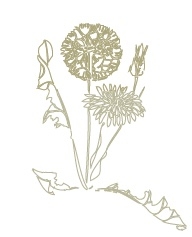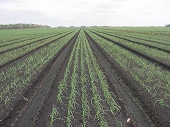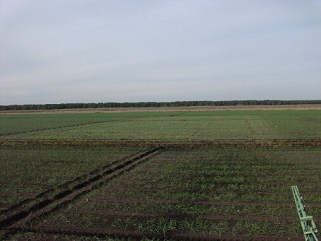Due to their slow growth, small stature, shallow roots, and lack of dense foliage, onions cannot withstand the ill effects of weeds (Ware & McCollum, 1975). Research has documented that onions are poor competitors (Jones & Mann, 1963; Tathum & Whitwell, 1968).
If onions are seeded in the fall and harvested in mid- to late-June, as most commercial onions in North Carolina are, long-term weed control is critical.
Season-long exposure of seeded onion to weed competition has been shown to reduce onion yield up to 96 percent (Bond & Burston, 1996). Other research has shown that leaving weeds for up to four to six weeks early in the season may not reduce seeded onion yields if weeds are controlled afterwards (Shabdolt & Holm, 1956; Hewson & Roberts, 1971) and that yields do not suffer after keeping weeds out of the crop for six to eight weeks before allowing weeds to establish (Hewson & Roberts, 1971). Therefore, the critical weed-free period for onion is approximately four to six weeks after crop emergence.
However, Menges and Tamez (1981) showed that in south Texas, the critical weed-free period for common sunflower in seeded onion was 2 to 12 weeks. With these variable results, it is safe to conclude that onions can withstand no competition from weeds and that any management scheme should be based on this conclusion.
Cultivation Options in Onions
To successfully achieve weed control in onions, one has to rely on different tools. In wide-row production, cultivation can help to keep the onions clean for a longer portion of the crop’s development. These cultivations should be shallow to avoid damaging the roots and the bulb.
Cultivation is a bit more difficult when producing onions in narrow rows on wide beds. Cultivation tools such as basket weeders exist for this, but they require extreme precision and are usually quite time consuming. Additionally, mechanical cultivation must be curtailed towards the end of the season, as the width of the bulbs leaves less room between the rows to place the implement. Hand weeding can also be employed in the fight against weeds. This can prove to be a slow alternative also, as well as possibly being cost-prohibitive (Nylund et al., 1958)
Herbicide Options in Onions
Scope
The predominant choice for weed control in onions is the use of herbicides. Several herbicides are registered for use in onions. The following information primarily addresses weed control in seeded, dry-bulb onion production—the dominant production system in North Carolina. References to transplanted onions and green onions may occur. However, for more information concerning weed control in these types of onion production, please refer to specific product labels and your local Extension agent or specialist.
Preplant and Preemergence
Paraquat (Gramoxone Inteon 2 SL, Gramoxone Max 3 SL, Firestorm 3 SL) may be used to nonselectively control emerged weeds prior to crop emergence. Paraquat will not translocate in plants as well as glyphosate, so it should be applied to small weeds. Preform beds several days before application to encourage maximum weed germination and emergence prior to treatment. Gramoxone Inteon may be applied at 2.6 to 4 pints per acre, while labeled rates of Gramoxone Max and Firestorm are 1.5 to 2.7 pints per acre (0.65 to 1 pound of active ingredient per acre). They may be applied with either a nonionic surfactant at a rate of 16 to 32 ounces per 100 gallons of water or a crop oil concentrate at 1 gallon per 100 gallons of water. Because paraquat does not translocate greatly within the plant, it has limited effectiveness on perennial weeds.
Glyphosate (Roundup and other trade names) may also be applied prior to crop emergence with the goal of killing emerged weeds. Similar to paraquat, it will nonselectively kill these weeds and will translocate in the plant to give better control of large weeds as well as perennials. Apply at a rate of 0.5 to 1.5 pounds of active ingredient per acre. Rate of product per acre will change based on the particular formulation being used. Some formulations of glyphosate have been manufactured with surfactants included and need no additional adjuvant.
Bensulide (Prefar 4 E) is labeled for preplant-incorporated and preemergence use in onions for control of annual grasses and small-seeded broadleaf weeds. Application rates range from 5 to 6 pounds of active ingredient per acre (5 to 6 quarts per acre). For maximum activity, the preplant application needs to be incorporated to 1 inch deep, while Prefar preemergence will need to be irrigated into the soil immediately for best activity. Of the important early-season weeds in North Carolina onions, Prefar controls most annual grasses and common lambsquarters.
DCPA(Dacthal W-75) may be applied preemergence to seeded onions or just after transplanting at rates of 6 to 7.5 pounds of active ingredient (8 to 10 pounds of W-75) per acre. Avoid cool, wet conditions at preemerence application. It may also be applied at layby. Dacthal will not control emerged weeds. See the label for instructions on layby application. The label claims control of most annual grasses, common chickweed, and common lambsquarters, while claiming suppression of henbit. Dacthal will not control wild mustard. The label also allows for use in green onions.
Pendimethalin (Prowl 3.3 EC) can be applied preemergence only to onions planted in muck soils. The label allows for use postemergence in all onions. For muck soils, the preemergence rate range is 1 to 2 pounds of active ingredient (2.4 to 4.8 pints) per acre. Prowl will control most annual grasses and many small-seeded broadleaf weeds, including common lambsquarters.
Postemergence
Pendimethalin (Prowl 3.3 EC) may be used postemergence on onions in both mineral and muck soils. The rate range for mineral soils is 0.5 to 1.5 pounds of active ingredient (1.2 to 3.6 pints) per acre. When applying Prowl postemergence to onions grown in muck soils, the rate range is 1.5 to 2 pounds of active ingredient (3.6 to 4.8 pints) per acre. Prowl may be applied any time between the two- and nine-leaf stages of onion growth on both soil types. Do not apply within 45 days of harvest. See the label for further precautions.
Dimethenamid (Outlook 6 EC) can be applied to control weeds that have not emerged in seeded onions after they have two true leaves. It can be applied as one application of up to 21 ounces per acre or as two applications—with 10 to 14 ounces per acre followed by 7 to 10 ounces per acre. A minimum of 14 days is required between sequential applications of Outlook. Outlook can be applied to transplanted onions after soil is firmly settled around transplants. It is also registered in many other crops for controlling annual grasses and many small-seeded broadleaf weeds, such as common lambsquarters and pigweed species. Do not apply within 30 days of harvest.
Oxyfluorfen (Goal 2 XL, Galigan 2 E) is the backbone of most onion weed-control programs. It may be used in both seeded and transplanted onions. Rates vary based on the production system. For transplanted onions, oxyfluorfen may be applied prior to transplant and soon after transplant. Apply Goal/Galigan at 0.25 to 0.5 pounds of active ingredient (1 to 2 pints) per acre after the final tillage operation or within two days after transplanting. For seeded onions, apply up to four times at 0.12 pounds of active ingredient (0.5 pints) per acre each time. However, applications may not begin prior to the two-true-leaf stage of onion growth, and no later than 45 days prior to harvest. The label lists control, suppression, or both of the following weeds if weeds are in the two- to four-leaf growth stage at application: cutleaf evening primrose, shepardspurse, carpetweed, Pennsylvania smartweed, common lambsquarters, wild mustard and others (see label). Application in muck soils may give partial control or suppression of the listed weeds. Do not apply Goal soon after periods of cloudy weather. This will increase the likelihood of phytotoxicity to the crop (see Figure 1).
Flumioxazin (Chateau 51 WDG) is registered for weed control in dry-bulb onions in several states, including North Carolina. It is registered for postemergence use on transplanted onions at the two- to six-leaf stage and on seeded onions at the three- to six-leaf stage for residual weed control. Do not apply preemergence to seeded onions. Research attempts to use this product preemergence in seeded dry-bulb onions resulted in severe crop injury or failure (Batts, unpublished data). At labeled rates for onions, Chateau controls some winter annual weeds, including common chickweed and henbit, as well as some problematic summer annual weeds, such as common lambsquarters, pigweed species, prickly sida and nightshade species (see label for a complete list of weeds). Do not apply more than 2 ounces per acre per application and no more than 3 ounces per acre per season. Sequential applications must be at least 14 days apart. Chateau may not be applied within 45 days of onion harvest. On soils with more than 90 percent sand, no more than 1 ounce per acre of Chateau may be applied per season. See the label for other precautions.
Fluazifop (Fusilade DX 2 EC) may be used for control of emerged grass species. It will not control broadleaf weeds or grasses that have yet to emerge. Apply at 0.1 to 0.25 pound of active ingredient (6 to 16 ounces) per acre. Include a crop oil concentrate at 1 quart for every 100 gallons of spray mixture. Avoid applications on excessive hot and humid days due to risk of crop injury under these conditions. Do not apply within 45 days of harvest. Fusilade is considered by researchers to be slightly better than Poast on perennial grasses, such as bermudagrass or Johnsongrass.
Sethoxydim (Poast 1.53 EC) may be used to control emerged grasses in both dry-bulb and green onions. Apply at 0.2 to 0.3 pound (1 to 1.5 pints) per acre. Poast will not control broadleaf weeds or grasses that have yet to emerge. Application must include 1 quart of crop oil concentrate per acre. Avoid applications on excessive hot and humid days due to risk of crop injury under these conditions. Do not apply within 30 days of harvest. Poast is slightly weaker on annual bluegrass than Select and Fusilade.
Clethodim (Select 2 EC, Select Max 1 EC) may also be used post-emergence for control of emerged grasses. It will not control broadleaf weeds or grasses that have not yet emerged. Application rates of Select 2EC range from 0.09 to 0.25 pound (6 to 16 ounces) per acre. One gallon of crop oil concentrate per 100 gallons of spray mixture is required. Select Max may be applied at 0.07 to 0.25 pound (9 to 32 ounces) per acre. Select Max should be applied with 1 quart of nonionic surfactant per 100 gallons of spray mix. Clethodim is very effective on annual bluegrass. Do not apply within 45 days of harvest. Clethodim provides good control of both annual and perennial grasses. These products are considered better on annual bluegrass than Poast.
Postemergence (Hooded/Shielded)
Glyphosate (Roundup and other trade names) may be applied as a hooded or shielded spray or wiper application to row middles between crop rows or as a post-harvest nonselective spray. Make every effort to avoid contact between glyphosate and an actively-growing onion crop. Apply at 0.5 to 0.94 pounds of active ingredient per acre. Rate of product per acre will vary based on the specific formulation. Some formulations of glyphosate have been manufactured with surfactants included and need no additional adjuvant.
Carfentrazone (Aim 1.9 EW, 2.0 EC) may be applied to small, emerged weeds in onions as a hooded or shielded application to row middles between crop rows. Up to 2 ounces per acre may be applied at any one application, with a seasonal limit of 6.1 ounces per acre for onions.
Contact with onion foliage during an application will result in crop injury. Good weed coverage is essential, so use a crop oil concentrate (1 percent of spray volume) or nonionic surfactant (0.25 percent of spray volume).
Recommended Weed Management Programs
Preplant: Glyphosate
Preemergence: Penidmethalin in muck soils only. Paraquat immediately prior to crop emergence. DCPA in mineral soils. Due to DCPA expense and rate required, a grower may choose to band and cultivate row middles between crop rows in wide-row onions.
Postemergence: Flumixazin followed by Oxyfluorfen, as needed. Fluazifop, Sethoxydim or Clethodim for emerged grasses.
Resources
Bond, W. and S. Burston. 1996. Timing the removal of weeds from drilled salad onions to prevent crop losses. Crop Prot. 15:205-211.
Hewson, R. T. and H. A. Roberts. 1971. The effects of weed removal at different times on the yield of bulb onions. J. Hort Sci. 46:471-483.
Jones, H. A. and L. K. Mann. 1963. Onions and their allies, botany, cultivations and utilization. Leonard Hill, London.
Menges, R. M. and S. Tamez. 1981. Common sunflower (Helianthus annus) interference in onion (Allium cepa). Weed Sci. 29:641-647.
Nylund, R. E., C. D. Nelson, and D. H. Dinkel. 1958. Comparative costs of weeding onions by hand or with monuron, CIPC, and CDAA. Weeds 6:304.
Shadbolt, C. A. and L. G. Holm. 1956. Some quantitative aspects of weed competition in vegetable crops. Weeds 4:111-123.
Tatham, P. B. and J. D. Whitwell. 1968. Herbicides on spring sown bulb onions. Prog. Rep. esp. Husb. Fms exp. Hort. Stns N.A.A.S., No. 9, 25-27.
Ware, G. W. and J. P. McCollum. 1975. Onions. pp. 359-377 in Producing vegetable crops, second edition. G. W. Ware and J. P. McCollum, eds. The Interstate Printers & Publishers Inc., Danville, IL.
Always read and understand the entire label prior to using any herbicide.
Prepared by
Roger B. Batts, David W. Monks, Wayne E. Mitchem, and Katie M. Jennings
Department of Horticultural Science
Publication date: Jan. 1, 2008
Reviewed/Revised: Jan. 30, 2024
AG-700-05
Recommendations for the use of agricultural chemicals are included in this publication as a convenience to the reader. The use of brand names and any mention or listing of commercial products or services in this publication does not imply endorsement by NC State University or N.C. A&T State University nor discrimination against similar products or services not mentioned. Individuals who use agricultural chemicals are responsible for ensuring that the intended use complies with current regulations and conforms to the product label. Be sure to obtain current information about usage regulations and examine a current product label before applying any chemical. For assistance, contact your local N.C. Cooperative Extension county center.
N.C. Cooperative Extension prohibits discrimination and harassment regardless of age, color, disability, family and marital status, gender identity, national origin, political beliefs, race, religion, sex (including pregnancy), sexual orientation and veteran status.



